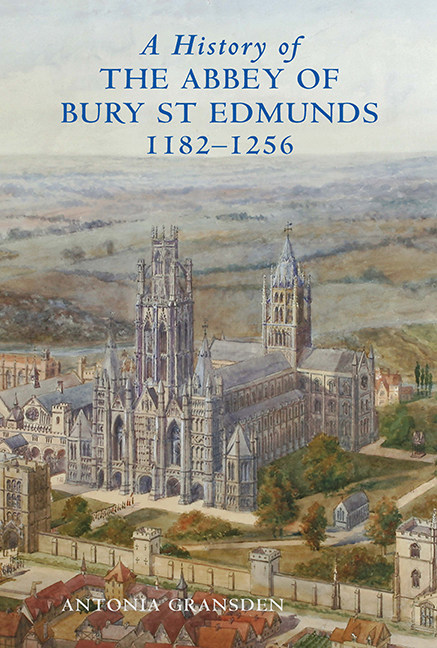Book contents
- Frontmatter
- Dedication
- Contents
- List of plates
- List of figures
- Preface
- Editorial Note
- Epigraph
- Acknowledgements
- Maps and plans (figures 1–9)
- Part I Samson of Tottington, Abbot 1182–1211
- PART II The Abbey 1212–1256
- 14 The vacancy, 1211–15, and election of Hugh of Northwold
- 15 The Abbots 1215–1256
- 16 Observance of the Rule of St Benedict
- 17 Learning
- 18 Books
- 19 Buildings
- 20 St Edmunds’ liberties and the Crown
- 21 Henry III and the cult of St Edmund
- APPENDICES
14 - The vacancy, 1211–15, and election of Hugh of Northwold
from PART II - The Abbey 1212–1256
Published online by Cambridge University Press: 29 April 2017
- Frontmatter
- Dedication
- Contents
- List of plates
- List of figures
- Preface
- Editorial Note
- Epigraph
- Acknowledgements
- Maps and plans (figures 1–9)
- Part I Samson of Tottington, Abbot 1182–1211
- PART II The Abbey 1212–1256
- 14 The vacancy, 1211–15, and election of Hugh of Northwold
- 15 The Abbots 1215–1256
- 16 Observance of the Rule of St Benedict
- 17 Learning
- 18 Books
- 19 Buildings
- 20 St Edmunds’ liberties and the Crown
- 21 Henry III and the cult of St Edmund
- APPENDICES
Summary
Abbot Samson died on 30 December 1211, and Hugh of Northwold, the subcellarer, was elected abbot on 7 August 1213, but did not receive papal confirmation until 10 March 1215. He was blessed by the bishop of Rochester, Benedict of Sawston, on 19 May, 1215, and eventually King John confirmed the election on 10 June. The reason for the long interval between Samson's death and the abbatial election was in the first instance the papal interdict which was pronounced in England on 23 March 1208 and lasted for over six years. It was not finally lifted until 2 July 1214 but negotiations to end it had been in progress for more than a year. For much of this time John was under sentence of excommunication: his excommunication was pronounced in England in November 1209 and he was not absolved until 20 July 1213. During the interdict, until John's absolution, vacant sees and abbeys were not filled. But once absolved John acted quickly. On 25 July he issued a general order for the filling of vacancies: St Edmunds received the mandate on 4 August. The monks immediately began the election procedure and Hugh of Northwold was elected. But then there was a further delay in filling the vacancy: for almost two years John repeatedly refused to confirm the election.
Hugh's election is of exceptional interest because it gave rise to a prolonged dispute within the convent of which a detailed and nearly contemporary account survives, the Cronica de electione Hugonis abbatis postea episcopi Eliensis. This has an added interest since detailed, contemporary or near contemporary accounts of abbatial elections in medieval England are rare. Indeed, the unusually good evidence surviving from St Edmunds is rivalled only by that from St Albans. Jocelin of Brackland gives a brilliant description of Samson's election in his biographical chronicle, with a lifelike account of the discussions in the cloister and of Samson's bearing and details of the election process itself. His account is well known. The Electio Hugonis is less well known and deserves more attention by reason of its rarity, high narrative quality and its content. It is the earliest chronicle devoted exclusively to an election to survive from St Edmunds.
- Type
- Chapter
- Information
- A History of the Abbey of Bury St Edmunds, 1182–1256Samson of Tottington to Edmund of Walpole, pp. 151 - 164Publisher: Boydell & BrewerPrint publication year: 2007



